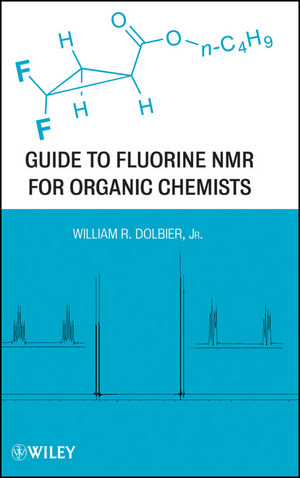
Guide to Fluorine NMR for Organic Chemists
Wiley-Blackwell (Verlag)
978-0-470-19341-9 (ISBN)
- Titel erscheint in neuer Auflage
- Artikel merken
William R. Dolbier, Jr., is the Col. Allen R. and Margaret G. Crow Professor of Chemistry at the University of Florida. He received his BS in chemistry from Stetson University in 1961 and his PhD in organic chemistry from Cornell University in 1965. Following a postdoctoral appointment at Yale University, he joined the faculty at the University of Florida in 1966. Professor Dolbier was the recipient of the 2000 American Chemical Society (ACS) Award for Creative Work in Fluorine Chemistry, and is a past member of the Executive Committee of the Fluorine Division of the ACS.
PREFACE. 1 GENERAL INTRODUCTION. 1.1. Why Fluorinated Compounds are Interesting. 1.2. Introduction to Fluorine NMR. References. 2 AN OVERVIEW OF FLUORINE NMR. 2.1. Introduction. 2.2. Fluorine Chemical Shifts. 2.3. Spin-Spin Coupling Constants to Fluorine. 2.4. 1 H Spectra of Fluoroorganic Compounds. 2.5. 13 C NMR Spectra of Fluoroorganic Compounds. 2.6. Isotope Effects on Chemical Shifts. 2.7. Advanced Topics. References. 3 THE SINGLE FLUORINE SUBSTITUENT. 3.1. Introduction. 3.2. Saturated Hydrocarbons. 3.3. Influence of Substituents/Functional Groups. 3.4. Carbonyl Functional Groups. 3.5. Nitriles. 3.6. Alkenes with a Single Fluorine Substituent. 3.7. Acetylenic Fluorine. 3.8. Allylic, Propargylic, and Benzylic Fluorides. 3.9. Fluoroaromatics. 3.10. Fluoroheterocycles. 3.11. Other Common Groups with a Single Fluorine Substituent. References. 4 THE CF 2 GROUP. 4.1. Introduction. 4.2. Saturated Hydrocarbons Containing a CF 2 Group. 4.3. Influence of Substituents/Functional Groups. 4.4. Carbonyl Functional Groups. 4.5. Nitriles. 4.6. Bifunctional CF 2 Compounds. 4.7. Alkenes and Alkynes. 4.8. Benzenoid Aromatics Bearing a CF 2 Group. 4.9. Heteroaromatic CF 2 Groups. References. 5 THE TRIFLUOROMETHYL GROUP. 5.1. Introduction. 5.2. Saturated Hydrocarbons Bearing a CF 3 Group. 5.3. Influence of Substituents and Functional Groups. 5.4. Carbonyl Compounds. 5.5. Nitriles. 5.6. Bifunctional Compounds. 5.7. Sulfonic Acid Derivatives. 5.8. Allylic and Propargylic Trifluoromethyl Groups. 5.9. Aryl-Bound Trifluoromethyl Groups. 5.10. Heteroaryl-Bound Trifluoromethyl Groups. References. 6 MORE HIGHLY FLUORINATED GROUPS. 6.1. Introduction. 6.2. The 1,1,2- and 1,2,2-Trifluoroethyl Groups. 6.3. The 1,1,2,2-Tetrafluoroethyl and 2,2,3,3-Tetrafluoropropyl Groups. 6.4. The 1,2,2,2-Tetrafluoroethyl Group. 6.5. The Pentafluoroethyl Group. 6.6. The 2,2,3,3,3-Pentafluoropropyl Group. 6.7. The 1,1,2,3,3,3-Hexafluoropropyl Group. 6.8. The Hexafluoro- iso -Propyl Group. 6.9. The Heptafluoro- n -Propyl Group. 6.10. The Heptafluoro- iso -Propyl Group. 6.11. The Nonafluoro- n -Butyl Group. 6.12. Fluorous Groups. 6.13. 1-Hydro-Perfluoroalkanes. 6.14. Perfluoroalkanes. 6.15. Perfluoro- n -Alkyl Halides. 6.16. Perfluoroalkyl Amines, Ethers, and Carboxylic Acid Derivatives. 6.17. Polyfluoroalkenes. 6.18. Polyfluorinated Aromatics. 6.19. Polyfluoroheterocyclics. References. 7 COMPOUNDS AND SUBSTITUENTS WITH FLUORIDE DIRECTLY BOUND TO A HETEROATOM. 7.1. Introduction. 7.2. Boron Fluorides. 7.3. Fluorosilanes. 7.4. Nitrogen Fluorides. 7.5. Phosphorous Fluorides. 7.6. Oxygen Fluorides (Hypofluorites). 7.7. Sulfur Fluorides. 7.8. The Pentafluorosulfanyl (SF 5 ) Group. 7.9. Bromine Trifluoride and Iodine Pentafluoride. 7.10. Aryl Halogen Difluorides and Tetrafluorides. 7.11. Xenon Difluoride. References. GENERAL INDEX. COMPOUND INDEX.
| Zusatzinfo | Illustrations |
|---|---|
| Verlagsort | Hoboken |
| Sprache | englisch |
| Maße | 161 x 235 mm |
| Gewicht | 586 g |
| Themenwelt | Naturwissenschaften ► Chemie ► Organische Chemie |
| ISBN-10 | 0-470-19341-7 / 0470193417 |
| ISBN-13 | 978-0-470-19341-9 / 9780470193419 |
| Zustand | Neuware |
| Informationen gemäß Produktsicherheitsverordnung (GPSR) | |
| Haben Sie eine Frage zum Produkt? |
aus dem Bereich



